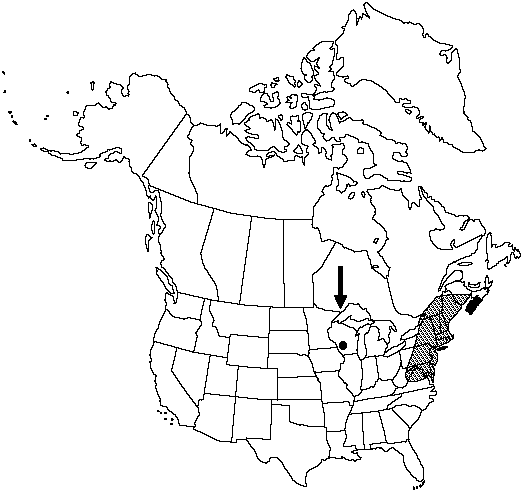Difference between revisions of "Thelypteris simulata"
Amer. Midl. Naturalist 1: 226. 1910.
FNA>Volume Importer |
imported>Volume Importer |
||
| (7 intermediate revisions by 2 users not shown) | |||
| Line 8: | Line 8: | ||
}} | }} | ||
|common_names=Massachusetts fern;thélyptère simulatrice | |common_names=Massachusetts fern;thélyptère simulatrice | ||
| − | |basionyms={{Treatment/ID/ | + | |special_status={{Treatment/ID/Special_status |
| + | |code=E | ||
| + | |label=Endemic | ||
| + | }} | ||
| + | |basionyms={{Treatment/ID/Basionym | ||
|name=Aspidium simulatum | |name=Aspidium simulatum | ||
|authority=Davenport | |authority=Davenport | ||
| + | |rank=species | ||
| + | |publication_title=Bot. Gaz. | ||
| + | |publication_place=19: 495. 1894 | ||
}} | }} | ||
|synonyms={{Treatment/ID/Synonym | |synonyms={{Treatment/ID/Synonym | ||
|name=Parathelypteris simulata | |name=Parathelypteris simulata | ||
|authority=(Davenport) Holttum | |authority=(Davenport) Holttum | ||
| + | |rank=species | ||
}} | }} | ||
|hierarchy=Thelypteridaceae;Thelypteris;Thelypteris subg. Parathelypteris;Thelypteris simulata | |hierarchy=Thelypteridaceae;Thelypteris;Thelypteris subg. Parathelypteris;Thelypteris simulata | ||
| Line 23: | Line 31: | ||
}}<!-- | }}<!-- | ||
| − | --><span class="statement" id="st- | + | --><span class="statement" id="st-undefined" data-properties=""><b>Stems </b>long-creeping, 1.5–3 mm diam. <b>Leaves</b> monomorphic, dying back in winter, often 1 cm or more apart, fertile leaves often somewhat longer than sterile leaves, 25–80 cm. <b>Petiole</b> straw-colored above base, 12–45 cm × 1–3 mm, at base sparsely set with tan, ovate, glabrous scales. <b>Blade</b> lanceolate, 14–35 cm, proximal pinnae largest, or lowest pair slightly smaller, blade tapered gradually to pinnatifid apex. <b>Pinnae</b> deeply pinnatifid to ca. 1 mm from costa, 3–10 × 1–2 cm; segments oblong, somewhat oblique, entire; proximal pair of veins from adjacent segments meeting margin above sinus. <b>Indument</b> abaxially of sparsely set hairs 0.2–0.4 mm primarily on costae, also of yellowish short-stalked glands less than 0.1 mm, blade tissue with numerous reddish to orangish, resinous, shiny, sessile, hemispheric glands; blades adaxially with scattered hairs on veins. <b>Sori</b> round, medial; indusia tan, often glandular; sporangia glabrous. <b>2n</b> = 128.</span><!-- |
-->{{Treatment/Body | -->{{Treatment/Body | ||
| Line 37: | Line 45: | ||
-->{{#Taxon: | -->{{#Taxon: | ||
name=Thelypteris simulata | name=Thelypteris simulata | ||
| − | |||
|authority=(Davenport) Nieuwland | |authority=(Davenport) Nieuwland | ||
|rank=species | |rank=species | ||
| Line 50: | Line 57: | ||
|publication title=Amer. Midl. Naturalist | |publication title=Amer. Midl. Naturalist | ||
|publication year=1910 | |publication year=1910 | ||
| − | |special status= | + | |special status=Endemic |
| − | |source xml=https:// | + | |source xml=https://bitbucket.org/aafc-mbb/fna-data-curation/src/2e0870ddd59836b60bcf96646a41e87ea5a5943a/coarse_grained_fna_xml/V2/V2_553.xml |
|genus=Thelypteris | |genus=Thelypteris | ||
|subgenus=Thelypteris subg. Parathelypteris | |subgenus=Thelypteris subg. Parathelypteris | ||
|species=Thelypteris simulata | |species=Thelypteris simulata | ||
| − | |||
| − | |||
| − | |||
| − | |||
| − | |||
| − | |||
| − | |||
| − | |||
| − | |||
| − | |||
| − | |||
| − | |||
| − | |||
| − | |||
| − | |||
| − | |||
| − | |||
| − | |||
| − | |||
| − | |||
| − | |||
| − | |||
| − | |||
| − | |||
| − | |||
| − | |||
| − | |||
| − | |||
| − | |||
| − | |||
| − | |||
| − | |||
| − | |||
| − | |||
| − | |||
| − | |||
| − | |||
| − | |||
| − | |||
| − | |||
}}<!-- | }}<!-- | ||
-->[[Category:Treatment]][[Category:Thelypteris subg. Parathelypteris]] | -->[[Category:Treatment]][[Category:Thelypteris subg. Parathelypteris]] | ||
Latest revision as of 20:24, 5 November 2020
Stems long-creeping, 1.5–3 mm diam. Leaves monomorphic, dying back in winter, often 1 cm or more apart, fertile leaves often somewhat longer than sterile leaves, 25–80 cm. Petiole straw-colored above base, 12–45 cm × 1–3 mm, at base sparsely set with tan, ovate, glabrous scales. Blade lanceolate, 14–35 cm, proximal pinnae largest, or lowest pair slightly smaller, blade tapered gradually to pinnatifid apex. Pinnae deeply pinnatifid to ca. 1 mm from costa, 3–10 × 1–2 cm; segments oblong, somewhat oblique, entire; proximal pair of veins from adjacent segments meeting margin above sinus. Indument abaxially of sparsely set hairs 0.2–0.4 mm primarily on costae, also of yellowish short-stalked glands less than 0.1 mm, blade tissue with numerous reddish to orangish, resinous, shiny, sessile, hemispheric glands; blades adaxially with scattered hairs on veins. Sori round, medial; indusia tan, often glandular; sporangia glabrous. 2n = 128.
Habitat: Terrestrial in acid soils of shaded swamps and bogs, frequently associated with sphagnum
Elevation: 0–100 m
Distribution

N.B., N.S., Ont., Que., Conn., Del., Maine, Md., Mass., N.H., N.J., N.Y., Pa., R.I., Vt., Va., W.Va., Wis.
Discussion
Selected References
None.